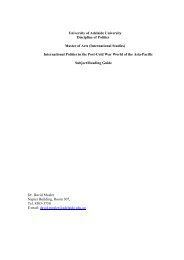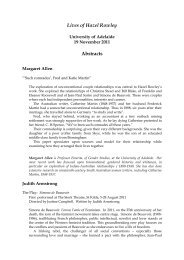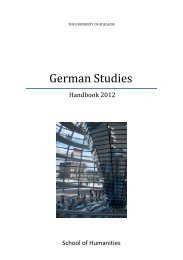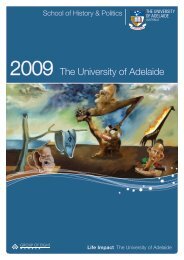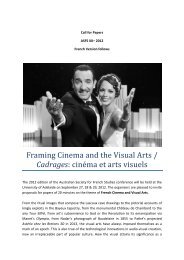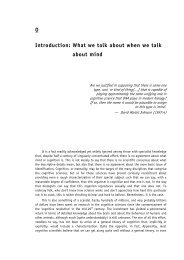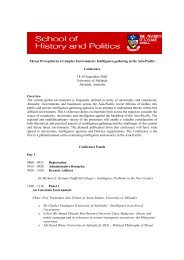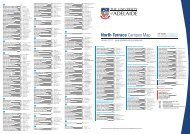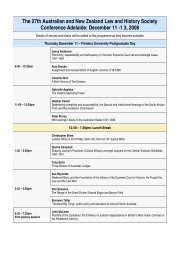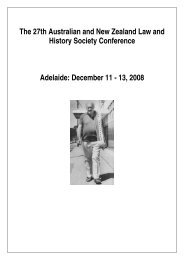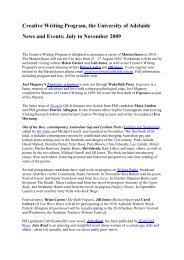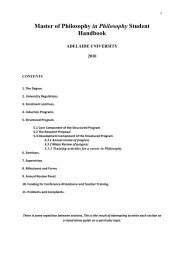Biohumanities - Paul Griffiths - Representing Genes
Biohumanities - Paul Griffiths - Representing Genes
Biohumanities - Paul Griffiths - Representing Genes
Create successful ePaper yourself
Turn your PDF publications into a flip-book with our unique Google optimized e-Paper software.
March 2008 “SCI-PHI” SYMPOSIUM<br />
41<br />
tual change in science is rationally motivated<br />
by the goals scientists have and by<br />
their accumulated experience of how to<br />
achieve their goals. Empirical science is a<br />
powerhouse of conceptual innovation. The<br />
gene concept is a case in point: in its century<br />
of existence the gene has been redefined<br />
many times, often radically. This<br />
makes sense if we think of concepts as tools<br />
of research, as ways of classifying the experience<br />
shaped by experimentalists to meet<br />
their specific needs. Necessarily, these<br />
tools get reshaped as the demands of scientific<br />
work change. In the study of conceptual<br />
evolution, the history of genetics<br />
provides a “conceptual phylogeny” of the<br />
gene. The <strong>Representing</strong> <strong>Genes</strong> Project was<br />
an attempt at “conceptual ecology”; that is,<br />
an attempt to determine some of the pressures<br />
that caused the gene concept to diversify<br />
into a number of different epistemic<br />
niches.<br />
In this section, we have given a brief<br />
description of some experimental philosophy<br />
of biology. We hope that these concrete<br />
examples give some substance to our<br />
claim that the humanities need not be confined<br />
to a discussion of the social or ethical<br />
consequences of biology, but can also contribute<br />
to a better understanding of biology<br />
itself, and to an understanding of, for<br />
example, what genes are and what it is for<br />
something to be innate.<br />
2. From Science Criticism to a New<br />
Vision of Postgenomic Biology<br />
<strong>Biohumanities</strong> is a critical enterprise<br />
that reflects on the epistemic virtues and<br />
limitations of current approaches. For example,<br />
an analysis of the gene concept<br />
should aim to shed light on the investigative<br />
utility and biases of gene-centered explanations<br />
in molecular, developmental,<br />
and evolutionary biology (Waters 2004).<br />
As a result of the <strong>Representing</strong> <strong>Genes</strong><br />
Project, we have come to embrace a version<br />
of the widely accepted dichotomy between<br />
an abstract, statistical gene and a<br />
concrete, mechanistic gene (Falk 2000;<br />
Gilbert 2000, 2003; Moss 2003), but have<br />
felt the need to introduce a further distinction<br />
between a simple “consensus gene,”<br />
based on prototypical examples of how genome<br />
structure supports genome function,<br />
and a “postgenomic gene” that embraces<br />
the messy reality of the wide range of<br />
known relationships between genome and<br />
genome product (<strong>Griffiths</strong> and Stotz 2006;<br />
see also Gerstein et al. 2007). We believe<br />
that the nature of the postgenomic gene<br />
supports the view that phenotypes are not<br />
simply expressions of genetic information,<br />
but rather emerge from a developmental<br />
system that encompasses many aspects of<br />
what would traditionally be regarded as the<br />
environment.<br />
Contemporary gene-centered accounts<br />
in molecular and developmental biology<br />
rest on a static, structural conception of<br />
the gene that clings as closely as the facts<br />
will allow to its starting point in the long<br />
superseded idea that one gene corresponds<br />
to one polypeptide. In its place,<br />
one of us has promoted the idea of “constitutive<br />
molecular epigenesis.” This replaces<br />
the metaphor of “gene action” with<br />
the more suitable metaphors of sequence<br />
“activation,” sequence “selection,” and sequence<br />
“creation.” These metaphors reflect<br />
what happens during the expression<br />
of the genome through transcriptional, cotranscriptional,<br />
and posttranscriptional processing<br />
of DNA coding sequences, when<br />
genes are composed on the fly by recombining<br />
in time- and tissue-specific ways the<br />
template capacity of the genome (Stotz<br />
2006a, 2006b).<br />
Postgenomic biology has brought with it<br />
a new conception of the “reactive genome”<br />
that is not only activated and regulated,<br />
but in which sequences are actively selected<br />
and newly created during an expression<br />
process that includes signals from the<br />
internal and external environment. This is<br />
congruent with the view that alleged explanatory<br />
categories such as “genetic” versus<br />
“environmental,” instead of explaining<br />
the origin of a phenotype, preclude further<br />
investigation into its real causes.<br />
The concept of a genetic trait, and the<br />
related idea of innateness, are often defended<br />
by pointing to the allegedly unique<br />
role of DNA in heredity. Transgenerational<br />
stability of form, however, requires



